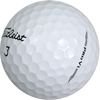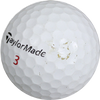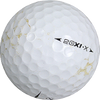 Okay class, the golf ball has come a long way. In the History of the Golf Ball Part 1, Part 2 and Part 3 we covered some truly whacky golf ball ideas – starting with Fred Flintstone's rock balls to ones made from wood, feather-stuffed leather, even balls made from the sap of the Sapodilla tree. Fortunately for all of us, these went the way of the Neanderthal (sorry Fred), and like the Neanderthal can occasionally be found fossilized at the bottom of ponds.
Okay class, the golf ball has come a long way. In the History of the Golf Ball Part 1, Part 2 and Part 3 we covered some truly whacky golf ball ideas – starting with Fred Flintstone's rock balls to ones made from wood, feather-stuffed leather, even balls made from the sap of the Sapodilla tree. Fortunately for all of us, these went the way of the Neanderthal (sorry Fred), and like the Neanderthal can occasionally be found fossilized at the bottom of ponds.
What put these balls – and we use that word loosely – out of business? The same thing that did in the pay phone. Modern technology. What else? The development of synthetic materials, computers, robotic testing and advanced production methods wildly accelerated golf ball advancements. In other words, golfers didn’t have to wait a couple hundred years for something new to come along. Breakthroughs were coming all the time.
If you want a starting point, we’d pick 1963 when a chemical engineer and inventor  named Jim Bartsch invented the first one-piece, molded synthetic-resin ball. This led to Spalding’s one-piece solid core ball – the Unicore followed by the Executive (ask Dad if he remembers these). Ram followed with the first ball featuring a super-tough DuPont Suryln ionomer resin cover (which eventually became a standard in the industry). There was the revolutionary Top-Flite from Spalding in 1972. More one-upmanship followed like the wound Titleist Tour Balata and its tougher-skinned brother, the Professional. There was Nike’s solid construction Tour Accuracy. Then, of course Titleist’s immensely popular 3-piece ProV1 and 4-piece ProV1x with their softer urethane covers. And that’s just a sampling of all the action.
named Jim Bartsch invented the first one-piece, molded synthetic-resin ball. This led to Spalding’s one-piece solid core ball – the Unicore followed by the Executive (ask Dad if he remembers these). Ram followed with the first ball featuring a super-tough DuPont Suryln ionomer resin cover (which eventually became a standard in the industry). There was the revolutionary Top-Flite from Spalding in 1972. More one-upmanship followed like the wound Titleist Tour Balata and its tougher-skinned brother, the Professional. There was Nike’s solid construction Tour Accuracy. Then, of course Titleist’s immensely popular 3-piece ProV1 and 4-piece ProV1x with their softer urethane covers. And that’s just a sampling of all the action.
But you get the idea. And the point – or punchline – of all of this is simple. You don’t  have to pay new ball prices anymore. Core and cover technologies are just so good, today’s used golf balls perform like-new even after months underwater, and we’ve got the data to prove it. Right here.
have to pay new ball prices anymore. Core and cover technologies are just so good, today’s used golf balls perform like-new even after months underwater, and we’ve got the data to prove it. Right here.
Missed Part 1, 2 or 3? You can read the whole History of the Golf Ball here.
Bonus Fact: In 1908 an Englishman named William Taylor patented the modern golf ball  dimple. Rumor has it that he carved the first experimental dimples with the scoop-end of a black head remover. Nice.
dimple. Rumor has it that he carved the first experimental dimples with the scoop-end of a black head remover. Nice.



